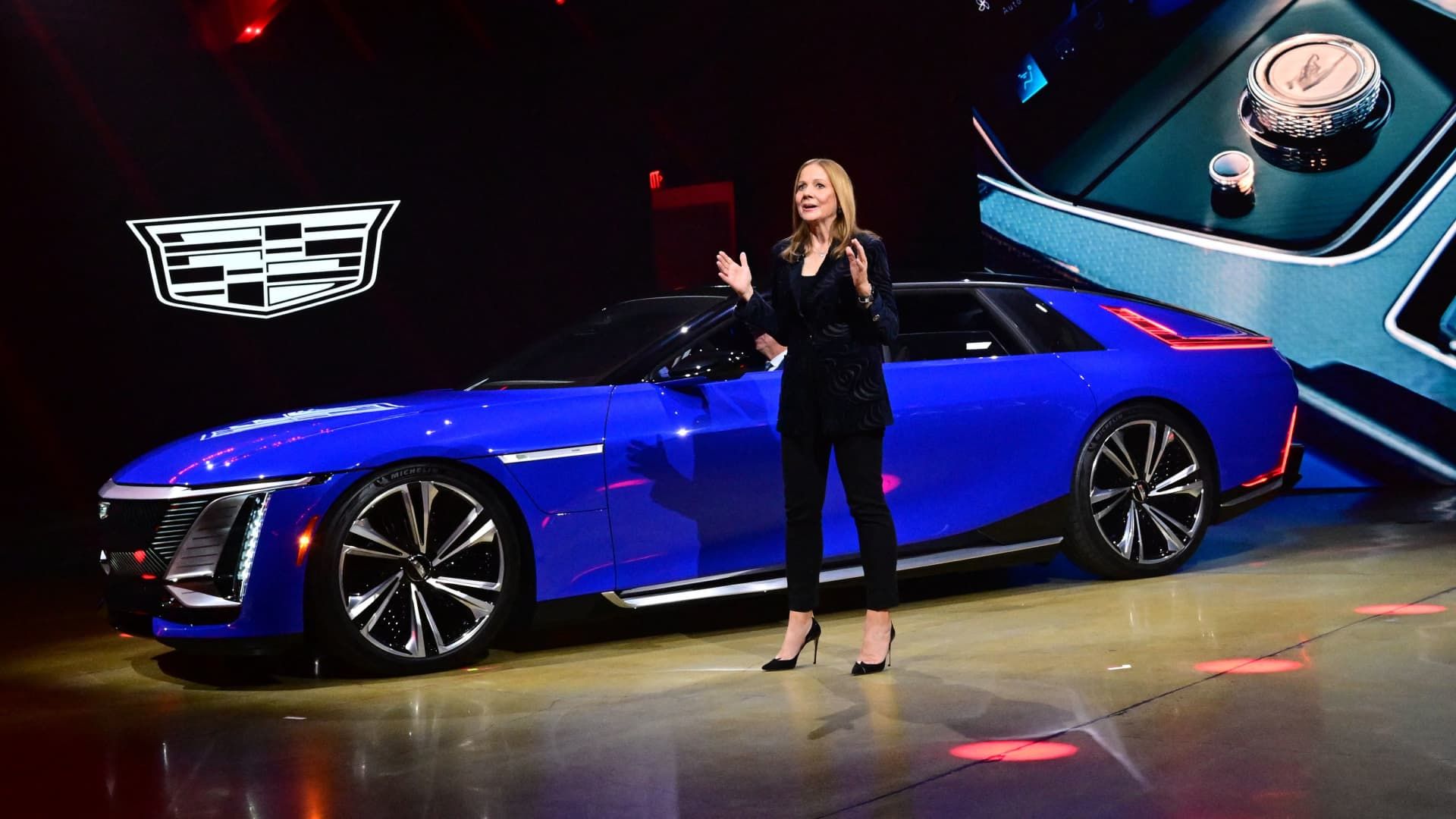GM President and CEO Mary Barra speaks during the unveiling of the Cadillac Celestiq electric sedan in Los Angeles, Oct. 17, 2022.
Frederic J. Brown | AFP | Getty Images
WARREN, Michigan – If everything had gone according to plan General Motors Over the past three years, the Detroit automaker is on track to achieve Tesla in sales of electric vehicles.
In October 2021, GM CEO Mary Barra stated that the automaker would “absolutely” catch up with the U.S. leader in electric vehicles by 2025. Instead, after slower-than-anticipated EV adoption across the industry and GM-specific challenges with production, software, and supply chains, the company remains far behind Elon Musk's automaker, as well as Hyundai Motor/Kia and Ford engine.
While GM has backed off most of its previously announced EV targets, the automaker believes its EV sales momentum is finally growing thanks to an expanding lineup of all-electric vehicles, which span a price range from about $35,000 to more than $300,000.
“We're definitely outpacing the industry in terms of growth, in terms of electric vehicles,” Rory Harvey, GM's president of global markets, including North America, told CNBC. “We have the most complete electric vehicle lineup of any manufacturer in the industry, in the U.S., right now.”
EV sales data provided to CNBC by the Detroit automaker, which publicly reports sales on a quarterly basis, shows a notable increase for GM through August. GM sold nearly 21,000 electric vehicles in the U.S. in July and August, nearly matching its second-quarter EV sales total. GM’s EV sales through August are up about 70% compared with a year earlier.
“It's a step change in terms of our performance in electric vehicles,” Harvey said during an interview this month at GM's Cadillac headquarters in suburban Detroit.
GM’s two consecutive record-breaking months for EVs put it within striking distance (about 2,000 units) of Ford through August. Still, it remained more than 20,000 units behind Hyundai/Kia’s EV sales through last month. Both Ford and Hyundai/Kia report sales on a monthly basis.
Traditional automakers are still fighting for a distant second place behind Tesla, which Motor Intelligence estimates sold more than 164,000 electric vehicles during the second quarter, roughly double the sales of GM, Hyundai/Kia and Ford combined during that time.
Harvey declined to speculate on when, or if, GM expects to overtake its competitors in electric vehicle sales, but the automaker is forecasting a strong finish to the end of the year.
“We have momentum on our side,” Harvey said. “We anticipate the fourth quarter to be strong in terms of EV adoption. So we're looking forward to that close and we expect to get a disproportionate share of the growth.”
Growing range of electric vehicles
GM currently offers eight “Ultium-based” electric vehicles for consumers, referring to its electric vehicle architecture and battery technologies.
Models range from mainstream models like the Chevy Equinox and Blazer crossovers to three full-size pickup trucks and Cadillac luxury models, including a custom-built $300,000 Celestiq. Two more Cadillac vehicles — an electric Escalade and an entry-level Optiq crossover — are expected to join the lineup before the end of the year, bringing the total to 10, an industry-leading number.
“They're doing what they said they were going to do. Their plan was to get Ultium and get it into a lot of cars relatively quickly,” said Stephanie Brinley, senior automotive analyst at S&P Global. “It didn't get up and running as quickly as they wanted. But that was the plan.”
2025 Cadillac Escalade IQ
Michael Wayland / CNBC
For comparison, Tesla’s five vehicles range from the Model 3 sedan, which costs about $39,000, to the Cybertruck, which costs more than $100,000. Hyundai, which includes its Genesis luxury brand and its Kia sibling, has a lineup of nine cars and crossovers ranging from the $34,000 electric Hyundai Kona to the $80,000 Genesis G80.
With so many GM models, expectations for increased sales are high. The automaker has spent billions of dollars developing the vehicles and now “the pressure is on to sell them,” Brinley said.
“The pressure is on to be able to steer consumer demand and meet it,” he said. “But it takes 10 to 15 years to get to a point where electric vehicles are more dominant than electric cars.” [internal combustion engines]And it may still take some time for consumers to get used to it.”
Cox Automotive expects electric vehicles to account for about 10% of total U.S. vehicle sales by the end of the year, up from 7.3% in the first quarter.
The all-electric Chevrolet Blazer EV.
Scott Mlyn | CNBC
Selling more electric vehicles still feels a bit counterintuitive for GM — they're still far less profitable than other gasoline-powered models — but the automaker expects EVs to become profitable in terms of production, or contribution margin, once it reaches output of 200,000 units in the fourth quarter.
Electric vehicles, which also help the company meet strict federal fuel economy standards, have been a major growth area under Barra. The CEO has yet to fully back off a goal announced in January 2021 that the automaker would exclusively offer all-electric vehicles to consumers by 2035.
Harvey told CNBC that the automaker is “doing a great job now in terms of roadshows, in terms of attracting customers to our vehicles and making sure that our fleets in our dealerships have the right level of electric vehicles.”
“In the US, they say that whoever gets behind the wheel sells cars; in the UK, we say that whoever gets behind the wheel closes the deal,” said Harvey, who is originally from the UK. “But it's the same thing.”
Electric Vehicle Targets
The 2035 target, which Barra has said will be guided by customer demand, was a transformative goal for GM. The Detroit automaker was the first traditional automaker to go “all in” on electric vehicles and reorganized its business to focus on vehicles, including announcing several other targets that have since been dropped or adjusted.
Among the dropped 2025 targets are a North American production capacity of 1 million electric vehicles and EV revenue comparable to that of gasoline models. The status of other targets, such as $50 billion in revenue from all-electric vehicles by next year, is unclear.
GM is maintaining a near-term goal of producing 200,000 to 250,000 electric vehicles this year, a range that was revised down from a previously announced target of 200,000 to 300,000.
Harvey said the company will continue to be guided by customer demand for electric vehicles.
“You have to plan several years in advance what you're going to do,” Harvey said. “If there are some peaks and dips along the way, then we have the ability to ramp up production or ramp it down slightly so that we can meet customer demand. I don't think we've invested too much in electric vehicles.”









